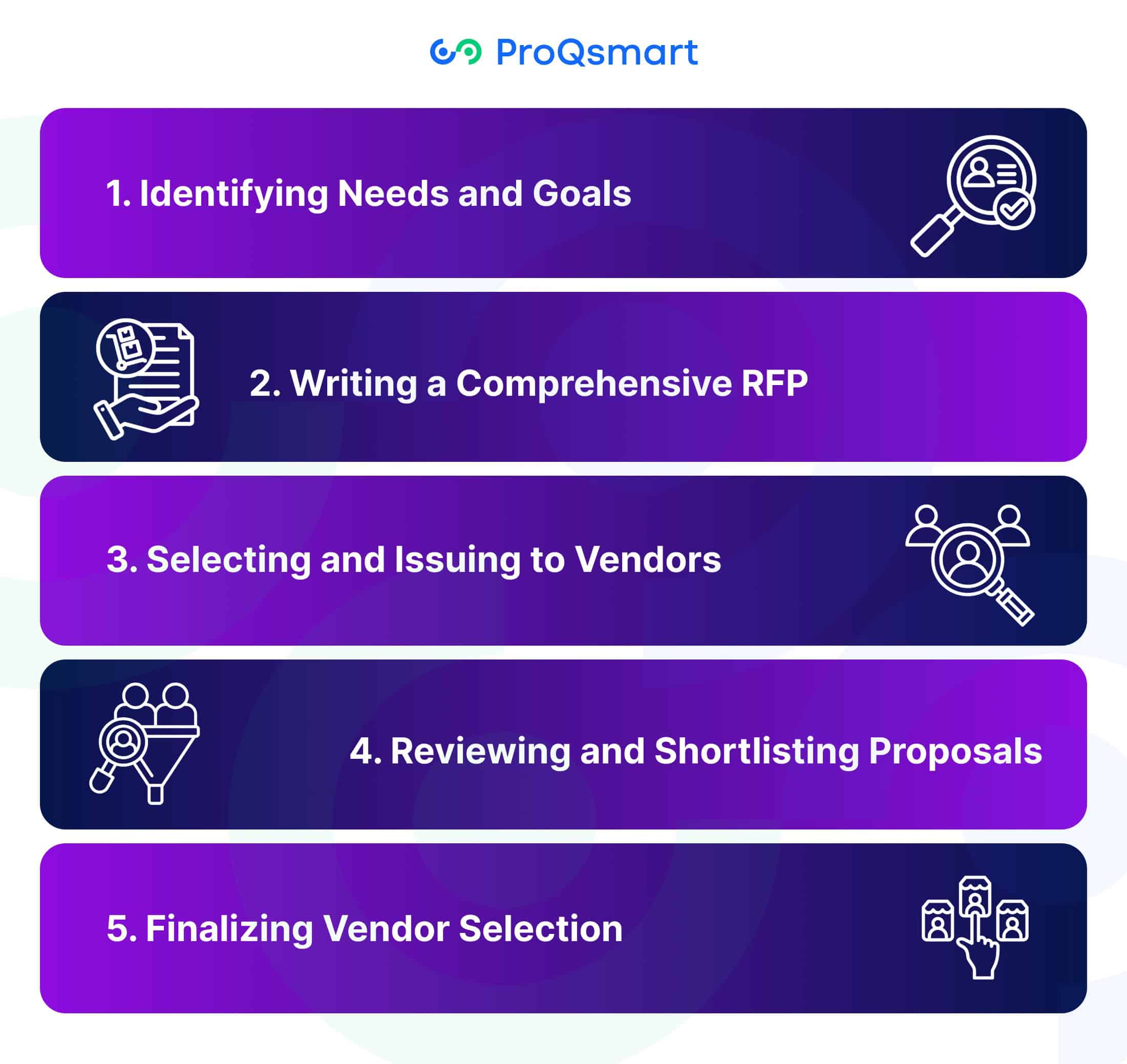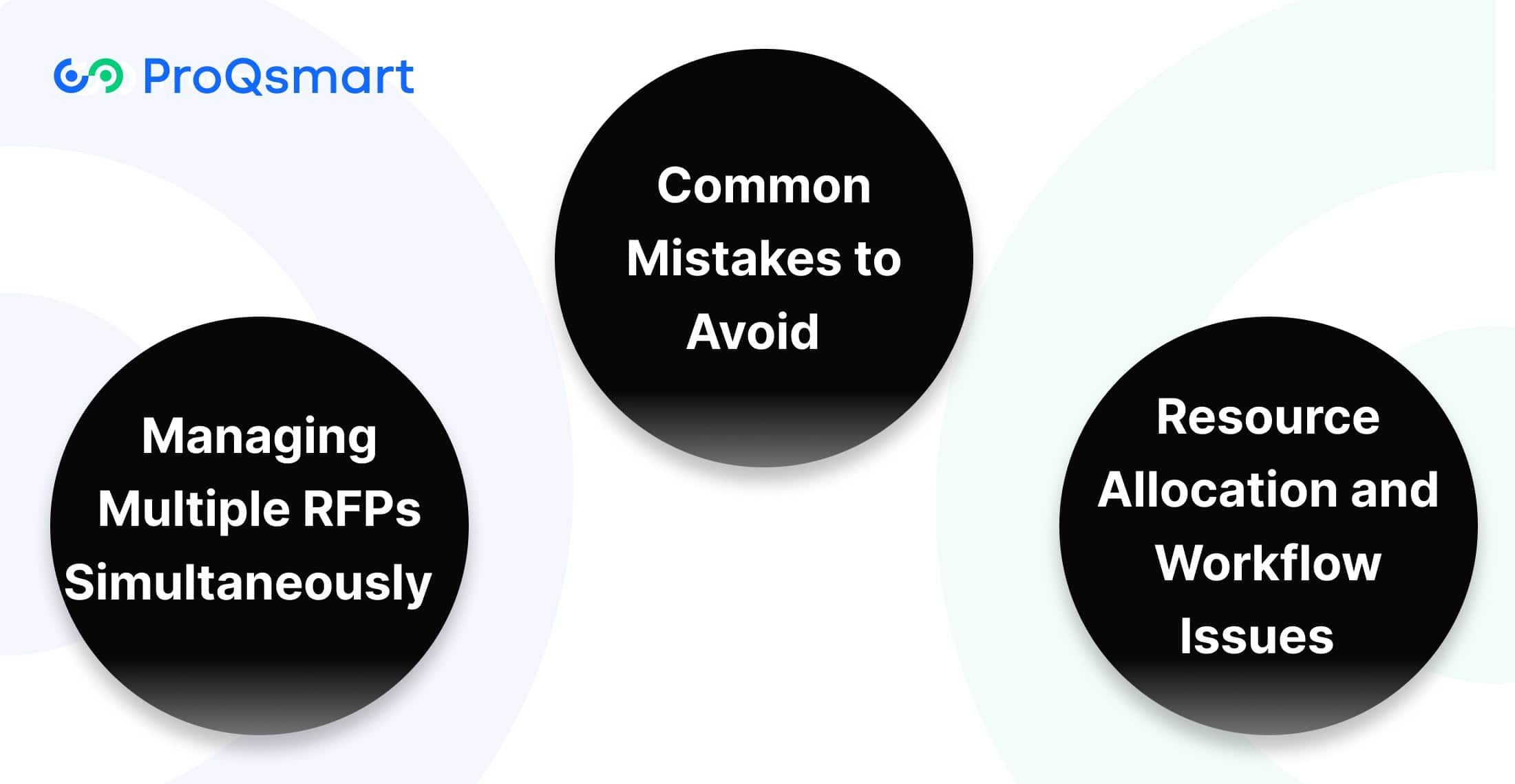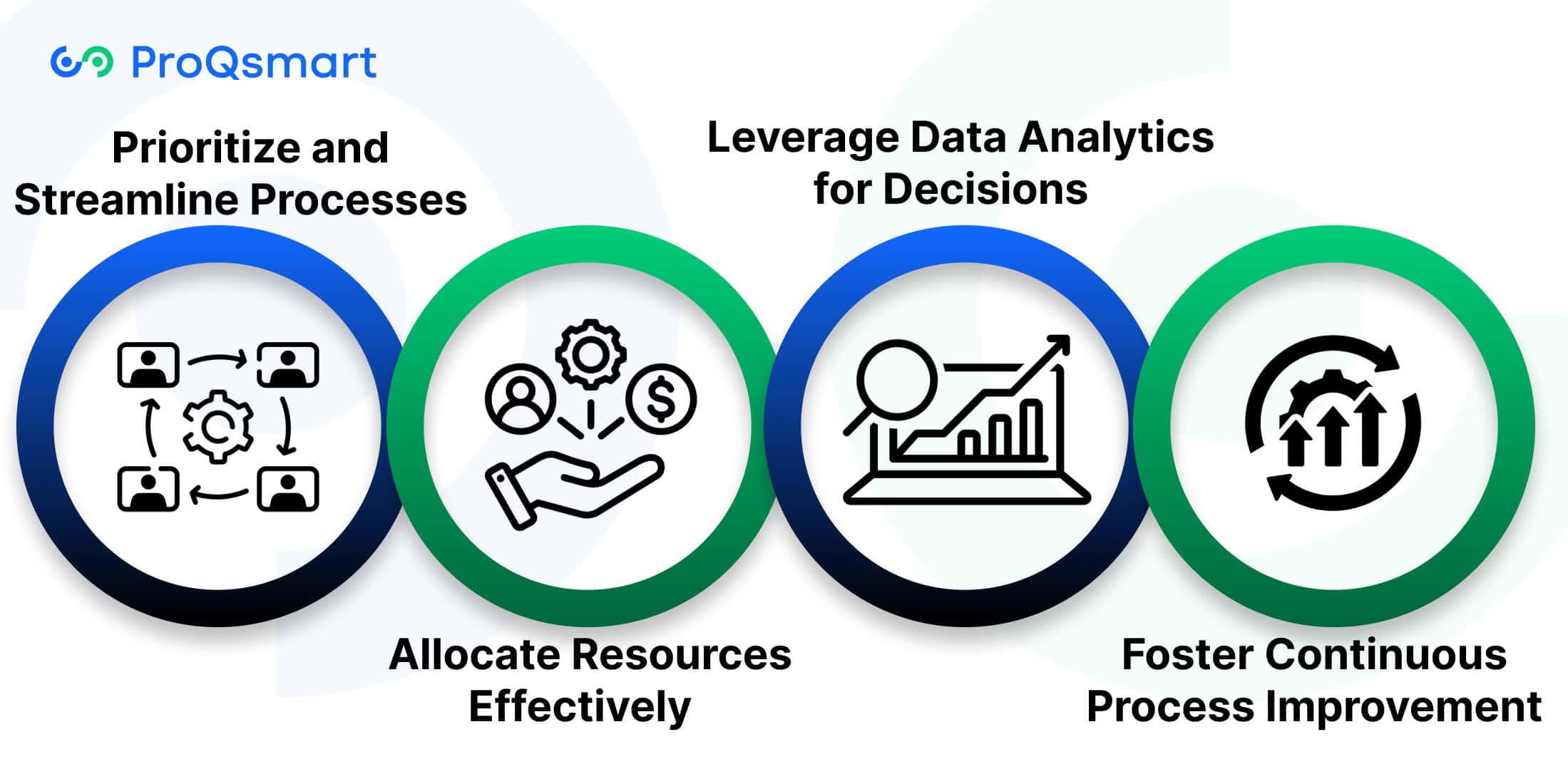An RFP, or Request for Proposal, is a pretty formal document. It is often used by organizations to gather comprehensive bids from qualified suppliers or service providers. It details the scope of work, criteria for evaluation, and rules for submission, fostering a fair and competitive procurement process.
RFPs help clarify expectations. This further allows businesses to select their best partner based on value, specialty, and alignment of organizational goals.
Integrating an RFP into your procurement strategy makes it easier to make decisions and minimize risk by creating a consistent evaluation process. This document not only creates accountability and compliance, it creates a space for creativity and innovation from vendors.
For procurement professionals, knowing how to best navigate RFPs is key to procuring the best solutions and ensuring long-term success in projects. A good RFP will save time and help develop more productive supplier relationships.
What Is RFP Management?
RFP management is the structured process of managing requests for proposals (RFPs) through procurement. That includes creating, distributing, collecting and evaluating proposals from potential vendors—making sure you have a smooth, orderly, and competitive process.
By providing a standardized approach to these steps, RFP management helps ensure clarity and consistency allowing organizations to compare and contrast vendor capabilities. This inclusive approach protects the integrity of the procurement cycle by ensuring that their procurement process is fair and unbiased.
By scoring each vendor against set criteria, it minimizes bias and encourages accountability. Smart RFP management helps you procure the right vendor that’s best aligned to your organization’s needs, which directly leads to better project outcomes.
For example, in a construction project, a well-managed RFP process can secure a supplier with a proven track record in delivering high-quality building materials under tight deadlines. It also builds trust and collaboration with vendors by establishing clear expectations on both sides.
How Does the RFP Process Work?

The Request for Proposal (RFP) process is a bureaucratic exercise. It protects taxpayers’ money and helps public organizations find the best possible vendors to execute their projects. By following a series of well-defined steps, businesses can evaluate vendor capabilities, align procurement strategies with objectives, and maintain transparency.
Below, we demystify the essential stages of the RFP process to arm respondents with actionable insights you can actually use.
1. Identifying Needs and Goals
The initial step is to determine internal needs by speaking with major stakeholders. Bringing in teams such as finance, operations, and IT can help ensure that all perspectives are taken into account.
Having specific goals provides a framework for the RFP and helps outline the key requirements for the project. For example, a construction-related project may require that the supplier has experience with sustainable materials.
Documenting these requirements up front helps keep everyone focused on the big picture business goals and helps vendors develop their best-customized proposals.
2. Writing a Comprehensive RFP
A well-crafted RFP document goes a long way. It needs to have a straightforward project summary, precise specifications, and information on how to submit.
Typical RFPs have 50 to 200 questions focused on vendor qualifications. Evaluation metrics should be clearly defined as well to establish expectations upfront.
Leveraging solutions such as ProQsmart can help streamline this phase by automating workflows, standardizing data, and making compliance easier.
"Don't let the complexities of RFP drafting slow you down. Download our ready-to-use RFP template and take the first step towards efficient vendor selection and project success"
3. Selecting and Issuing to Vendors
Choosing the highest qualified vendor according to your predetermined criteria is crucial. For example, organizations may want to give preference to vendors who are familiar with the procurement process driven by the budget.
Issuing the RFP through all available channels including digital platforms helps to get the word out further. ProQsmart’s e-tendering feature simplifies this process by creating a shared space for keeping documents organized and encouraging collaboration between suppliers.
4. Reviewing and Shortlisting Proposals
Once responses are in, a careful, structured evaluation process is required. This process includes scoring proposals based on factors including price, conformity, and technical capabilities.
Stakeholders should participate to provide diverse input. Applications such as ProQsmart improve transparency by closely monitoring supplier performance and aligning supplier capabilities with the goals of the project.
5. Finalizing Vendor Selection
The final stage includes contract negotiation to clarify terms and responsibilities. Conducting risk assessments ensures potential challenges are addressed.
Comprehensive documentation of agreements is key to maintaining accountability. ProQsmart’s AI-driven features support capital expenditure sourcing and supplier management, providing unmatched efficiency and cost savings.
When to Use an RFP?
A Request for Proposal, or RFP, is a critical strategic procurement tool that can be used to meaningful sourcing decisions. Its intention is much deeper than just requesting bids, looking to collect rich and comparable information from prospective vendors.
Issuing an RFP at the appropriate time allows organizations to better focus their procurement resources. This alignment balances operational goals with stakeholder expectations.
Differences Between RFx Documents
Document | Purpose | Usage Context |
RFP | Request detailed proposals from vendors | Complex projects requiring evaluation of capabilities |
RFQ | Request cost estimates for specific goods/services | Straightforward purchases, price-focused decisions |
RFI | Gather preliminary information and narrow down options | Early-stage vendor screening |
Each has a very different purpose in procurement. The RFI produces a list of vendors that are qualified to fulfill the requirements while the RFQ only focuses on cost.
Choosing the right document is crucial for effective communication and smooth processes.
Challenges in RFP Management

The myriad complexities that come with managing Requests for Proposals (RFPs) present unique challenges that can significantly impact efficiency and effectiveness if not tackled head-on. These challenges run the gamut from balancing tight timelines with thorough stakeholder engagement to supporting clarity and strong processes.
The burdensome RFP process is no friend to procurement teams within small and medium-sized enterprises (SMEs). It requires a great level of strategy and finesse, thus making it a resource-heavy endeavor.
Managing Multiple RFPs Simultaneously
Managing several RFPs simultaneously takes a rigorous process to prevent overwhelming valuable resources and ensuring precision. Implement project management tools such as Trello or Asana to monitor the status of each RFP.
These tools allow you to stay on task and avoid miscommunication. Assigning different members of your team to manage individual RFPs helps bring focus to your efforts.
This strategy goes a long way in minimizing the chance of missteps and holdups. Establishing clear communication channels, whether through regular meetings or collaborative platforms like Slack, keeps everyone aligned and ensures seamless updates across all stakeholders.
Common Mistakes to Avoid
Common traps that RFP managers fall into are writing unclear criteria, not researching vendors thoroughly, and lack of communication. Even these simple oversights can result in misinterpretation and lack of response.
Mistakes can be avoided with proper preparation. Rethink and Rework Review previous RFPs and get your subject matter experts (SMEs) on the ground floor right at the start.
Continuously revising and improving RFP materials will help to make sure they stay as clear, concise, and focused on organizational goals as possible.
Resource Allocation and Workflow Issues
Determining resource needs at the start of the RFP process is key to avoiding bottlenecks. More than a third of these searches cost 25 minutes of prep time per document.
This makes the case for smarter resource allocation even more urgent. SMEs feel the pain of spreadsheet-driven inefficiencies and manual processes.
Establishing streamlined workflows with technology such as RFP-specific software can improve internal collaboration and save time while minimizing costly errors.
By keeping an eye on resource utilization across the RFP lifecycle, it’s easy to keep teams working at their most productive—even at full capacity.
Emerging Trends in RFP Management
The RFP management process is ever-changing, influenced by new technologies, procurement strategies, and market expectations. To remain competitive, organizations must understand the rfp process guide and emerging trends, which are crucial for achieving greater efficiency and innovation in a dynamic procurement environment.
Technology Integration in RFPs
Digital platforms are accelerating this transformation by changing how RFPs are managed. Solutions such as ProQsmart enable easier document management, improved collaboration, and automated workflows, creating a more efficient process for procurement teams.
For instance, ProQsmart’s e-tendering capabilities facilitate streamlined communications with suppliers, eliminating more manual processes and keeping you compliant. Since just 32% of APMP members report using dedicated RFP tools, there’s a huge advantage to adopting technologies like these.
Automation reduces the risk of human error and ensures faster and more accurate submissions, giving teams time back to invest in strategic initiatives. For vendors, these systems provide a clearer, more organized, more transparent process that ultimately improves the quality of the proposal and overall vendor engagement.
Data-Driven Decision-Making Processes
Furthermore, data analytics has become central to evaluating vendor proposals and performance. Through platforms such as ProQsmart, organizations are now able to see suppliers’ performance metrics, monitor alignment with budgets, and measure compliance.
By using a data-driven approach, agencies are better equipped to make informed decisions, yielding better outcomes. With RFPs impacting 30-40% of revenue, utilizing analytics to help you fine-tune your selection criteria will help ensure you get the best results.
Transparency and Improved Communication
Open communication is vital in establishing trust and developing stronger collaboration, especially during the RFP process. ProQsmart’s easy transparency features, including real-time updates and auditable sourcing data, ensure that potential vendors remain informed, fostering a healthy environment for negotiations and collaboration.
By eliminating miscommunication and increasing supplier accountability with transparent processes, you enhance the procurement decision-making process, ultimately leading to a successful outcome in vendor bids and long-term supplier relationships.
Sustainability in Vendor Selection
We’re seeing sustainability being prioritized more and more in RFPs. Today, businesses want to work with vendors that prioritize environmentally sustainable practices that align with their organization’s values and strengthen their reputation.
ProQsmart facilitates this by recording sustainable practices in supplier scorecards, allowing procurement teams to focus on suppliers that reflect their environmental initiatives.
Personalization of Proposals
Tailored proposals that address these needs have emerged as the new baseline. Vendors that focus on personalization have higher acceptance rates and improved vendor engagement.
This further highlights how key it is to understand the needs of the client and tailor the response to align with their vision and objectives.
"Don't let the complexities of RFP drafting slow you down. Download our ready-to-use RFP template and take the first step towards efficient vendor selection and project success"
Strategies to Improve RFP Management

Properly managing the RFP process is the foundation of successful procurement. It protects against scope creep, helps organizations find the best possible solutions to meet their needs, and saves time and money. Having a sound RFP process can go a long way in creating a consistent, transparent, and goal-oriented approach.
Here are some specific strategies to help your organization do a better job on RFP management.
Prioritize and Streamline Processes
Finding the right activities to streamline starts with looking for high-impact activities that drive successful RFP outcomes. For example, automating detailed RFP responses with specialized software cuts the manual labor by more than half, saving hours without compromising quality.
Resources, such as project management software, make it easier to establish priorities and track deadlines, helping teams stay on track to meet key milestones. Using a more standardized process, such as the 7-step RFP process, increases your dissemination and messaging preparation.
It helps you to develop an equitable evaluation structure. Centralizing these activities on a platform such as ProQsmart greatly increases efficiency. It combines e-tenders, workflows, and document management into one seamless process.
Allocate Resources Effectively
Resource assessment should occur early in the RFP process. By evaluating team capacity and project requirements, organizations can allocate resources strategically, preventing bottlenecks.
Efficient resource distribution keeps teams balanced, avoiding burnout while maintaining productivity. ProQsmart’s real-time tracking and budget alignment features automate resource allocation, ensuring compliance with organizational objectives.
Monitoring usage throughout the RFP lifecycle allows for adjustments based on performance and workload needs.
Leverage Data Analytics for Decisions
Data analytics revolutionizes the entire decision-making process by offering new, actionable insights. By using historical performance data to evaluate vendor proposals, organizations can make smarter choices that best position them to achieve long-term goals.
Analytics not only help to spot trends, but empower procurement teams to better tailor future RFPs. For instance, taking advantage of ProQsmart’s supplier performance monitoring tools helps make sure vendors fulfill contract terms every time.
Data-driven strategies improve the quality of evaluation and create accountability and transparency across the entire process.
Foster Continuous Process Improvement
Continuous improvement involves ongoing RFP management practice reviews. User feedback remains the most important aspect of our process for identifying gaps and making improvements.
By proactively addressing market changes or internal needs, you can help ensure that the RFP process stays relevant and effective. Take, for example, the fact that 72% of firms intend to respond to more RFPs each year, which highlights the need for flexible, innovative approaches.
Benefits of Efficient RFP Management
Managing RFPs (Request for Proposals) efficiently is key to any effective procurement strategy. Using RFP templates offers benefits that dramatically enhance project delivery and performance. Organizations can expedite vendor selection by prioritizing efficient processes supported by streamlined technology, fostering better vendor collaboration and ultimately producing higher-quality proposals.
Faster Vendor Selection Process
Efficient RFP management expedites the vendor selection process. This saves teams time by allowing them to quickly focus on the vendors that best meet their needs. Streamlined workflows and automated tools, like ProQsmart’s e-tendering and document management solutions, cut down on repetitive bid evaluations and get you the best bidders with clear deadlines.
This method helps keep projects moving by stopping bottlenecks before they happen, and just one delay can sink entire schedules. Teams with dedicated response management software are able to monitor evaluation criteria with precision. This emphasis on technical expertise often makes up 40% of the points in the decision-making process.
Quicker selections keep projects moving to stay on time, increasing the chances of overall success.
Improved Collaboration with Vendors
Clear, consistent communication goes a long way toward building trust with new vendors. Streamlined RFP processes allow for real-time collaboration, such as through ProQsmart’s supplier relationship management tools. By bringing in vendors early and keeping them involved, you can foster alignment with project goals and budget concerns.
Creating clear and concise requirements enables vendors to submit focused proposals that match the organization’s needs, creating a win-win scenario. Collaborative approaches lead to better proposals too. By keeping everyone in the loop and on the same page, everyone’s needs can be addressed.
Enhanced Proposal Quality and Outcomes
How effectively you manage your RFP process has a direct correlation to the quality of vendor proposals. In addition, having clear, specific requirements and evaluation criteria helps vendors focus their responses more effectively on meeting the goals of the project.
ProQsmart provides innovative analytics and content management solutions. These tools make it easier for teams to polish their responses and adhere to contract terms, and essential features and functions.
These processes help enhance the clarity of proposals submitted and, in turn, yield the best possible project outcomes. With better visibility into their workflow, teams can better prioritize tasks, allocate resources more effectively, and identify bottlenecks to ensure all deadlines are met without sacrificing quality.
Best Practices for Hospitality Industry
Strategic practices make for competitive RFP management in the hospitality industry. These tactics make the procurement process more efficient while catering to the sustainability objectives that are specific to each hotel’s goals.
By integrating clear objectives, technology, and customization, hotels can enhance their efficiency and strengthen relationships with suppliers and vendors.
Define Clear Objectives and Scope
Setting specific goals from the beginning helps keep the RFP process on track. For instance, if a hotel aims to improve its sustainability efforts, this goal should be clearly communicated to potential vendors.
Working closely with internal stakeholders—including sales and operations teams—ensures you’re able to clearly define the scope of your project. This alignment leads to proposals that are more directly applicable, relevant, and actionable—cutting down on ambiguities.
Establishing a timeline, which includes submission deadlines and major milestones, ensures that the process is organized and on schedule.
Use Centralized Management Tools
Centralized management tools help streamline communication and keep everyone organized. For instance, platforms like ProQsmart offer tools including real-time collaboration, automated workflows, and supplier performance tracking.
These tools allow hotels to take full control of e-tenders, monitor budgetary requirements and compliance with ease. By promoting transparency and minimizing manual work, these types of platforms increase competition and strengthen decision-making to further drive best value.
Automate Repetitive Tasks for Efficiency
You can automate important tasks such as sending reminders and tracking documentation. This end-to-end approach saves time and minimizes the risk of manual errors. Automation helps with uniformity, particularly when it comes to scoring vendors against predefined metrics like their room count or language capabilities. By automating the repetitive tasks with technology, procurement teams can spend more time making strategic decisions, making the vendor selection process more efficient.
Customize RFPs for Specific Needs
Personalization is key in getting the attention of vendors who can work in concert with a hotel’s strategy to create the best experiences for guests. Specific RFPs focus on special project needs, making the proposals you get back more relevant.
When pursuing group bookings, hotels can unlock a highly profitable segment. They can tailor requests for supporting needs, like bed configurations or language services.
Beyond the better outcomes, this kind of personalization goes a long way towards creating happier, healthier vendor relationships and partnerships.
Conclusion
Better results come from more efficient RFP management. It saves time, saves money, and adds certainty to the decision process. By emphasizing mutual understanding of goals and objectives, and open lines of communication, you foster better relationships with vendors and promote fair competition. When you’re proactive about trends such as automation and sustainability, you put yourself ahead of the game in an ever-evolving, competitive market.
As with every industry, the hospitality industry runs best on order and foresight. By adhering to these best practices, you set yourself up for a smooth and successful RFP process. Working hard and showing up all the time makes for stronger collaborative partnerships and provides more enduring success.
To continuously improve your own RFP process, it doesn’t take monumental reforms to achieve significant impact. Even small, strategic changes can lead to substantial gains in efficiency and effectiveness. With ProQsmart, you can create a smoother, more streamlined operation that positions your company for future growth. ProQsmart’s AI-powered features, centralized platform, and collaborative tools empower you to save time, win more business, and optimize every aspect of your RFP management.
Ready to revolutionize your RFP process? Schedule a demo with ProQsmart today and discover how our solutions can help you achieve unprecedented levels of efficiency, collaboration, and success.






